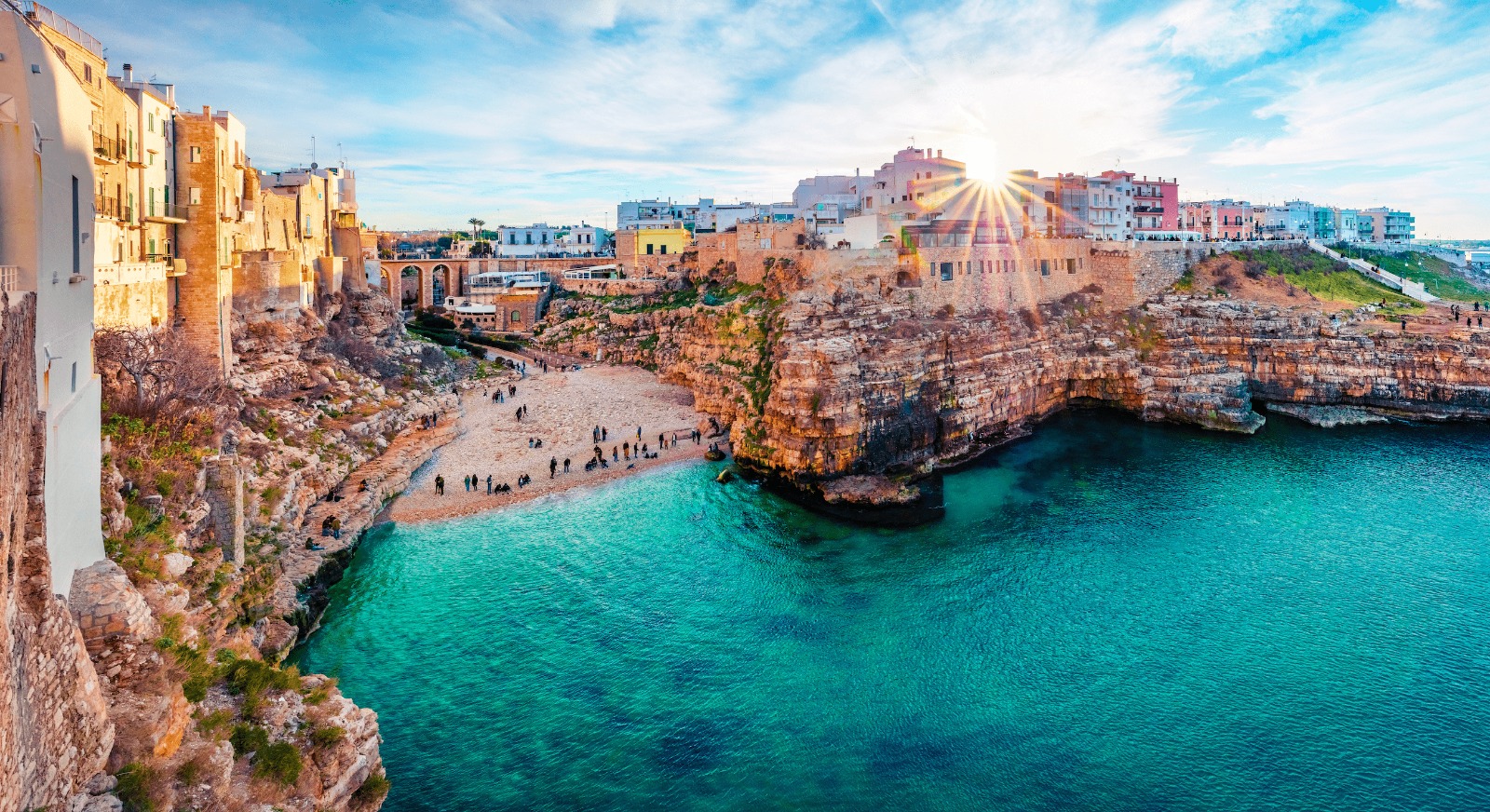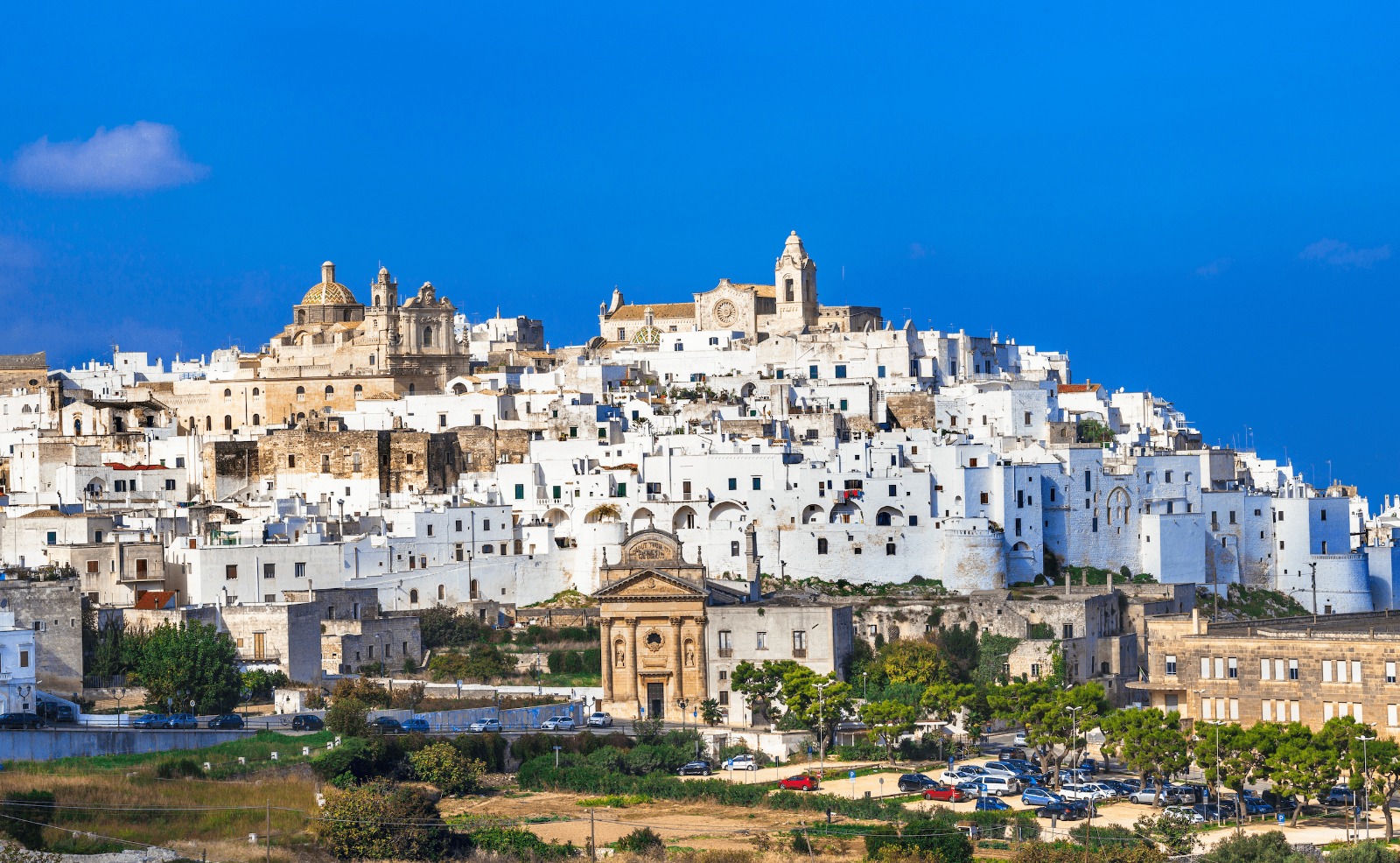SAVELLETRI DI FASANO
Savelletri di Fasano is an authentic and genuine territory: a place of hospitality, of historical and cultural traditions. This is the ideal location to welcome the event; it ensures the possibility to discover apulian’s landscape with its extraordinary white roads, confirming and relaunching the image of a beautiful and hospitable Region even outside the borders, giving a strong boost to seasonally adjusted tourism and the development of a sustainable economy, helping to enrich the system of offer and create new travel motivations.
POLIGNANO A MARE
Polignano a Mare is located only 23 kilometers from Sevelletri, rises on the eastern coast of Puglia and with its mild climate is one of the most visited and appreciated places in the world.
The main feature of this place, in fact, is its position: the historic center stands on a rocky outcrop overlooking the Adriatic Sea. Its wealth lies in tourism linked to marine activities and agriculture, it is no coincidence that the FEE (Foundation for Environmental Education) has awarded Polignano a Mare the Blue Flag since 2008.
History à Already from the Neolithic there are traces of human presence in this area, according to some archaeological studies, it can be identified in the ancient Greek city of Neapolis, which was one of the two colonies founded by Dionysius II of Syracuse in the 4th century BC. Other studies confirm the birth of a real port of call, which brought the populations of the surrounding villages, during the 2nd millennium BC. to move to where the historic center of Polignano stands today.
During the Middle Ages, in the 6th century, Polignano was under the jurisdiction of the Byzantine Empire of which the Orthodox religion was adopted. Then came the Normans, who dominated until 1194, the prestige of the town grew, thanks also to the work of the Benedictines, present with two monasteries. Thanks to the Angevin domination, commercial relations grew and became more and more flourishing with other coastal towns and many businessmen and merchants, including Venetians, chose Polignano as their home.
In the 16th century, following the siege of Monopoli, Polignano also fell under Venetian rule for twenty years. In fact, even today in the historic center it is possible to admire the Doge’s palace, where the Venetian governor resided.
In 1530 Polignano was ceded by Venice to Charles V, emperor of Spain. During the Aragonese dominion, commercial activities developed under the control of expert Venetian merchants. Works were erected to defend the town, starting from the coast. Nonetheless, Polignano cannot be counted among the most important Renaissance ports, due to its location overlooking the sea which prevented it from having an efficient port – thus explaining the mostly agricultural vocation of the city dedicated, yesterday as today , to trade with the hinterland.
On 5th August 1862, with an official document, the city was authorized to assume the name “Polignano a Mare”.
The town became a place of visit for royalities: in 1797, King Ferdinand I of the Two Sicilies, accompanied by his wife and son, stopped there on his way to Lecce and, after 10 years, King Giuseppe Bonaparte was there too received with great celebrations.
Subsequently, with feudalism abolished, Gioacchino Murat wanted to visit the Kingdom of Naples, including Polignano, to enhance its military capabilities.
What to visit à Nowadays Polignano is known for its spectacular natural landscapes, its sea caves, its historical center and the remains of Roman domination.
Among its natural beauties we must mention Cala Paura, made up of two inlets and a dock for small traditional boats. You can walk on the smooth pebbles, lie down on the pier or dive from the cliff into the transparent waters from which you can glimpse the rocky seabed.
Lama Monachile is another of the pearls of this wonderful city, (also called Cala Porto) wedged between two high rocky walls, its enchanting little beach, sports the Blue Flag and 4 Legambiente Sails.
A few steps from the historic center of Polignano a Mare, the most famous and photographed scenery of the Bari coast unfolds. The crystalline water caresses the white and smooth pebbles of the cove while a dreamy setting unfolds all around: the sea caves, the high and jagged cliffs and the houses of the ancient village overlooking the sea.
The beach takes its name from the Roman-era bridge, still passable, which crosses Lama Monachile and which meets the route of the ancient Via Traiana which offers postcard views.
But Polignano is also topical, for several years it has given space to the Red Bull Cliff Diving World Series, the competition, one of the most extreme and exciting in the world, in its 14 years of life it has passed through these parts 9 times, thus making the Apulian town the European home of the discipline.
During a visit to this locality, a visit to Pescaria cannot be missed, the first fish fast food restaurant in Italy, an idea born in Polignano that slowly conquered the whole of Italy.
FUN FACT: Polignano a Mare is the birthplace of the singer-songwriter winner of the Sanremo Festival, Domenico Modugno, who became famous with his “Nel blu dipinto di blu”.
MONOPOLI
Monopoli (from the Greek monos and polis) means unique city and it certainly still lives up to its name today. The city, in fact, retains the charm that derives from its history and its traditions.
The city develops along 15 km of low and indented coast, with numerous coves with suggestive names and long sandy beaches which represent a safe haven for vacationers and tourists for their holidays.
History à From the discoveries made, the human presence in the territory from the Paleolithic age was ascertained, as evidenced by the finds found in the Grotta delle Mura near Cala Porto Rosso.
From the 7th century with the Longobard domination and starting from 663, with the Byzantine one, the rise of Monopoli began, which became an important emporium and seat of flourishing maritime trade.
It is from 1049 the beginning of the Norman domination. After commercial relations with Genoa, Venice and Amalfi were intensified, important defensive works were started, the ancient port covered up with sand and a larger one was built, the city acquired great importance among the ports of the Adriatic. The Swabians and Frederick II took over from the Normans from 1220 to 1248. Monopoli will retain the title of state-owned city even under the Angevin and Aragonese dynasty. Starting from 1495 Monopoli was conquered by the Venetians who left numerous footprints in the field of culture and commerce. But the Spaniards, far from being tamed, often reappeared on the city and, following ups and downs, conquered it definitively in 1530, the year in which Monopoli was sold by Charles V, as a barony, to Pietro Faraone of Messina.
The glorious event of the redemption took place on April 18th of that same year when the citizens, competing, paid with rings, gold and necklaces in order to keep the city’s title of state-owned city not enslaved to any nobility. With the Spaniards, meanwhile, the city was fortified with walls. The construction of the Castle of Charles V dates back to this century. The period of Spanish misgovernment, known from the pages of history, also affected Monopoli.
In 1713 the Austrian domination took over which lasted until 1734 when the Bourbons conquered the Kingdom of Naples.
On 16th February 1796, with a decree from the King of Naples, the construction of the new city extra moenia was approved, according to Murat’s canons.
At the beginning of the century XIX was occupied by the French. From a cultural point of view, the presence of the literary circle that took the name of Accademia dei Venturieri, considered a colony of Arcadia, should be noted. The Bourbons returned until the unification of Italy, the city joined Piedmont with a plebiscitary vote.
Monopoli in 1972 received the title of Citta&grave and the Silver Medal of Civil Merit for the rescue brought by citizens to the shipwrecked Greek ship “Heleanna” off the Adriatic coast.
What to visit à A tour in the historic center of Monopoli can only start from the Porto Vecchio, here you can admire an enchanting postcard landscape, with the pretty blue boats, typical of fishermen, which help to sweeten the view. Its origins are very remote, most likely it dates back to the Messapian era of the fifth century. B.C.
Important coastal fortifications overlooked its seafront, including the Carlo V castle of Monopoli. Standing out over the sea with all its grandeur, in the past it was the seat of the highest military authority in the city, while today it is a place of culture and tradition; every summer there are literary reviews and the famous PhEST, the widespread photographic festival.
The first beach you come across south of Monopoli, just outside the walls, is Cala porta vecchia. Here there is a shallow and sandy bottom, ideal for less experienced swimmers. It is very easy to reach on foot with a walk from the city which makes it often crowded. The beach is dominated by a large railing from which to look out and be enchanted by the blue that reaches the horizon.
Continuing southwards, you arrive at Cala tre buchi. It is made up of a series of very small beaches, set among the rocks. An ideal place to enjoy peace and relaxation!
For the more adventurous and for those who love to take a regenerating bath in cold water, a highly recommended destination is the small beach of Porto Ghiacciolo. With shallow waters and clear green water, it offers a very suggestive location since it is located at the foot of the ancient abbey of Santo Stefano. The beach is also equipped with a bar, a deck chair rental service and a large car park nearby.
Another well-known seaside resort is the hamlet of Capitolo, a few kilometers from the urban center of Monopoli. The white and clean beach stretches for several kilometers and lends itself to long and relaxing walks along the coast.
ALBEROBELLO
Alberobello can also be referred to as the capital of the trulli, extraordinary examples of dry stone building with conical or pyramid-shaped roof slabs, with an expanse of over 1,500 trulli which since 1996 have rightfully entered the UNESCO World Heritage List .
The name Alberobello derives from Silva alboris belli, with the meaning of “forest of the tree of war” and this derivation, devoid of documentary evidence, has long been adopted by later historians. Later studies, however, underline that the first toponym by which the locality was known was Silva Alborelli: this is the result of the oldest document known to scholars.
Historyà The history of Alberobello is not as old as one might think. The town as we can admire it today was born at the end of the 14th century by the will of the Counts of Conversano, landowners who entrusted the management of the territory to some farmers. The law of the Kingdom of Naples provided for the payment of a tax for each new village built and, according to some studies, the trulli are the result of a stratagem devised to avoid paying those taxes.
The appearance of these constructions had to be deliberately precarious to give the impression of easily demolished buildings in the event of an inspection. After an initial settlement of about 40 trulli, in 1620 there was an important expansion. Only in 1797 was Alberobello freed from all tax requests and from the feudal servitude of the Counts on the decision of Ferdinand IV of Bourbon, king of Naples. But the trulli tradition has never stopped.
What to visit à Let’s start from the Trullo Sovrano, located in the northern part of the city: it is the only two-story trullo in the town and is set up with original furniture from the early twentieth century.
Rione Monti, the largest and most famous district of Alberobello boasts about 1,000 trulli. Absolutely to be seen are the Siamese Trulli, two centrally fused cones which, according to legend, symbolize the story of love and hate that engulfed two brothers.
We also mention Rione Aia piccola, the smallest neighborhood in the historic center of Alberobello. Here there are about 400 trulli for residential use.
Casa Pezzolla, is a complex of 15 communicating cones which houses the Museum of the Territory, can be visited for free. Also unmissable Casa D’Amore, a historic house from 1797, the first building built after Alberobello was freed from any tax request by the King of Naples.
Finally, the Belvedere Santa Lucia is the most evocative observation point in the city. Visiting it at sunset is an unmissable experience.
It is strongly recommended to get lost among its trulli and its charming shops, you will seem to find yourself in a fairy tale.
OSTUNI
«Ostuni è la città panoramica per eccellenza, ogni casa è un belvedere, ogni trattoria è della Bellavista, ad ogni finestra v’è un poeta che guarda nella pianura sottostante gli ulivi che cangian colore a tutti i venti […] A Ostuni le case sono bianche, di latte e calce, sono bianche fino a far male agli occhi, sono candidi i muri, le finestre, le porte, le scale, tutto è inverosimilmente bianco. […] A Ostuni si va per capire cosa vuol dire stare al riparo dal sole […] per non desiderare più romanzi, per non pensare più a viaggi lontani, qui c’è il fascino di tutte le città dei mari del Sud, qui c’è l’equatore a portata di mano.»
(Ettore Della Giovanna)
“The white city”, can be seen from afar and is recognized above all, Ostuni is a unique glance of its kind, its origins are very ancient historiographical sources ascertain, in fact, the presence of man since the Neandethal era. It seems that it was precisely the abundant presence of caves that constituted the ideal habitat for the presence of primitive man.
History àwe have to wait until 1000 BC to talk about the first city settlement, attributed to the Messapians and subsequently destroyed by the fury of Hannibal. In the meantime, Ostuni was rebuilt but passed from domination to domination with the Longobards, the Saracens, the Moors, the Swabians and the Normans, who traced the exact borders of the territory.
However, it was in the Renaissance period, following the annexation to the Duchy of Bari, that Ostuni experienced its maximum splendor as well as its maximum urban expansion. The idyll ends in the seventeenth century, a period in which Ostuni is sold to the Zevallos family who try to establish a real feudal regime. These are dark years for the city, also bent by the spread of the plague.
It was the Bourbons who brought Ostuni back to light and contributed to its further expansion towards the hills of Cappuccini, Sant’Antonio and Casale. It was in this period that the city center moved from Piazza del Moro to today’s Piazza della Libertà. After centuries of foreign domination, Ostuni obtained its freedom in 1799, establishing itself as a free and republican city. 61 years later it will be the first Apulian city to raise the tricolor.
What to visit à To best visit the city, it is worth enjoying a slow-paced walk to see every detail of this enchanting place. The small village has in fact maintained its medieval form and it will be a pleasure to get lost in its details.
Worth admiring is the suggestive Gothic Cathedral, built in the second half of the 15th century in “docile stone” on commission from two sovereigns of the Kingdom of Naples, Ferdinand of Aragon and Alfonso II respectively.
A stop at the Osteria del Tempo Perso is the best way to end the visit to this Apulian town, through their dishes you can discover another stronghold of Apulian culture: food.







